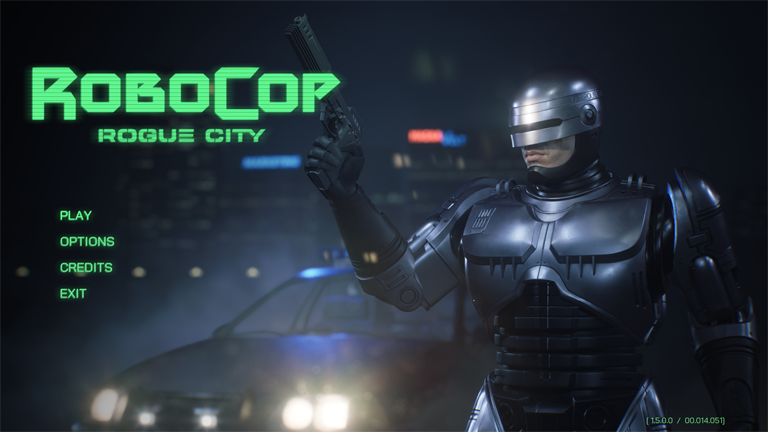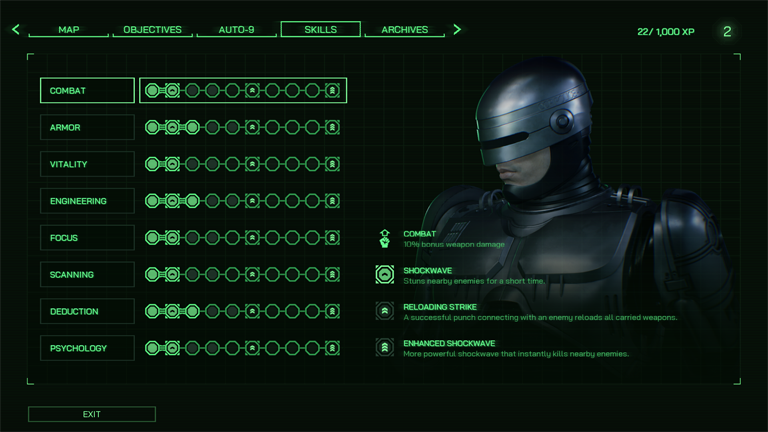The subhead says it all: RoboCop: Rogue City is a worthwhile buy of a story-rich FPS, but definitely not at its full price of 49 USD.

The second proper game in Teyon's new lineup, which marks a departure from the studio's 13 year record of releasing casual "games" for the console market, Rogue City follows the formula they used in Terminator: Resistance to a tee, resulting in the same, "smaller, dumbed-down DeusEx with Fewer Things To Do" gameplay I described in my Resistance review — except with ladders!
The graphics, sound and feel of the game perfectly recreate its source material, with characters (such as Sgt. Reed, Anne Lewis or, indeed, Alex Murphy – still voiced by Peter Weller, bless his 76-year-old ticker); locations and equipment lifted straight from Paul Verhoeven's 1987 cult classic. Where faithfulness to the source material is concerned, Teyon are far ahead of the curve (for visual appeal, despite the disparity in budget, studio size and relative experience, I would easily put Rogue City on par with Avalanche's Mad Max – which, to me, is the gold standard for movie license games). The impressive quality of the visuals is not all-encompassing, however, with some cheaper finish showing in places.
Spoiled as I am by CDPR's glorious Cyberpunk 2077 first-person view that lets you admire your own pants or footwear, it's a bit of a strain to go back to the old FPS "floating head" model that doesn't show the player's body (moreso in a scenario where said body is titanium and bullet-proof). It would have been a hoot to be able to glance down at Robo's chest-plate mid-firefight and see bullets ping off it in real time.

Navigating the brand-new ladders feels more like floating next to them than climbing and picking up objects has a weird, magnetic tic to it – with objects sort of leaping into Robo's hands when you toggle the action. To be fair, Teyon is a smaller, AA studio and their solutions are serviceable, but considering how nice the rest of the execution is, the contrast is more than a little jarring.
Last thing to note about the graphics is that the Unreal Engine they're running on is pretty poorly optimized, with some stuttering and clipping present, every now and again. But, that aside, Rogue City runs pretty smoothly and (to date) has not crashed on me once.
Gameplay is pretty much what it was in Terminator: Resistance, split evenly between an RPG-lite walking simulator and an FPS, except without the benefit of an inventory (the only thing Murphy owns – the iconic Auto 9 pistol – can be modified via a clever little puzzle mini-game, however).
The Metro West precinct and Old Detroit offer you a chance to stomp around and talk, complete short vignettes for experience and help out fellow officers or citizens. Teyon included a nice touch in the form of the law/community divide, allowing you to resolve situations "by the book" or on behalf of the citizenry (which sometimes affects the outcome of quests or how NPCs will treat you later in the game). It's a pleasant enough counterpoint to the frenetic shooting and over-the-top violence that round out the rest of the RoboCop: Rogue City experience.

Speaking of which, other locations (much like the entire game) are fairly linear, A-to-B-with-obstacles affairs that see you plod through an area while dispatching countless waves of armed opponents. Murphy's Auto 9, which has to be reloaded but has unlimited ammo, can be complemented with one other firearm taken from your opponents (ranging from pointless 9mm pistols, UZIs or TEC-9s all the way up to G-11s, M-60s, Barretts and grenade launchers).
The game's shooting sections are tactically interesting insofar as Robo – while sturdy – doesn't move very quickly and (on hard difficulty and up) is a single grenade away from the scrap heap at all times.
To offset being outnumbered and outgunned in every engagement, you can invest points into an eight skill, ten-point-deep tree that will make Murphy deal more damage, extend his bullet time, up his armor rating or gain more experience from found items.

Each skill also has three special abilities that unlock at the two, six and 10 point threshold, which further extend your arsenal of tricks with an electric discharge that can stun (or later kill) enemies, a "shield" that significantly decreases received damage, an auto-reload when Robo punches enemies (sure!), or even regeneration (why not!?).
Between walking, talking, finding doodads for XP and So. Much. Shooting, Rogue City also offers a handful of scripted, linear quests (such as investigations) and shorter vignettes. Gameplay variety is limited, but what's there is entertaining enough to keep you invested for the 17 or so hours it'll take to finish the game.
Overall, Teyon didn't so much push their boundaries with RoboCop: Rogue City as simply reaffirm their existence and it is now an Established Fact that the dev can masterfully recreate the assets and feel of an existing IP... But while the formula makes for a perfectly serviceable (if brief) bit of entertainment, I can't help but feel as if a little more effort would have made for a truly great game.
Maybe next time, eh?
In the meantime, Rogue City is a must-have for any die hard fans of the original movie or FPS afficionados looking for a hefty dose of nostalgia... Just wait until it's on sale. For as pretty as the game is, there isn't enough of it to justify spending 50 bucks.
Pig Recommends
-
-watching the original, 1987 film, RoboCop, Fred Dekker's 1993 second-sequel (RoboCop 3) or even the stilted but watchable 2014 reboot attempt (annoyingly, also called RoboCop); much like the game, they're fun for what they are, with Verhoeven's 1987 original (in my opinion) being the best of the lot; and staying far away from RoboCop 2 (which replaced Neumeier and Miner – two competent screenwriters – with Frank Miller and went down the drain whistling);
-
-skipping the paid Alex Murphy Pack and Vanguard "DLCs", which are mere re-skins of in game assets and add nothing to the overall experience;
